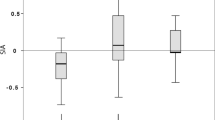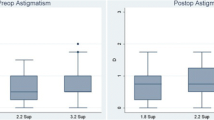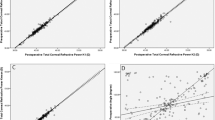Abstract
Introduction
High astigmatism is an important cause of poor uncorrected visual acuity after cataract surgery.
Purpose
The aim of the study is to compare the astigmatism induced by a superior and temporal incision in manual SICS, and to compare the astigmatism induced by clear corneal incision versus scleral tunnel in phacoemulsification surgery.
Methods
A total of 64 eyes of 64 patients (34 male/30 female) with a mean age of 62.10 years (range 45–82 years) were included in the study. The cases were randomly divided into two groups. One group (Group I) had undergone manual SICS and the other group (Group II) had undergone phacoemulsification. The manual SICS group patients were randomly allotted into two subgroups depending on the site of incision. Group Ia received superior incision while group Ib received temporal incision. The Phacoemulsification group (Group II) patients were randomly divided into two groups depending on the location of the incision. Group IIa received clear corneal incision and group IIb received scleral pocket incision. Informed consent was obtained from all the patients undergoing study. Surgically induced astigmatism is calculated by the substraction method.
Results and Conclusion
We found significantly against the rule shift in stigmatism in the phacoemulsification group and the manual SICS superior incision group. The manual SICS group with temporal incision (Ib) had with-the-rule shift in astigmatism.
Synopsis
At 90 days, conventional SICS superior incisions gave 1.92 ± 0.53 D against the rule and temporal incisions 1.57 ± 0.24 D with the rule astigmatism. Phacoemulsification clear corneal incisions showed 1.08 ± 0.36 D and scleral pocket 1.23 ± 0.71 D astigmatism.




Similar content being viewed by others
References
Thulasiraj RD, Nirmalan PK, Ramakrishnan R, et al. Blindness and vision impairment in a rural south Indian population: the Aravind Comprehensive Eye Survey. Ophthalmology. 2003;110:1491–1498.
Thulasiraj RD, Rahamathulla R, Saraswati A, et al. The Sivaganga eye survey: I. Blindness and cataract surgery. Ophthalmic Epidemiol. 2002;9:299–312.
Nirmalan PK, Thulasiraj RD, Maneksha V, et al. A population based eye survey of older adults in Tirunelveli district of south India: blindness, cataract surgery and visual outcomes. Br J Ophthalmol. 2002;86:505–512.
Murthy GVS, Gupta S, Ellwein LB, et al. A population-based eye survey of older adults in a rural district of Rajasthan. I. Central vision impairment, blindness and cataract surgery. Ophthalmology. 2001;108:679–685.
Thylefors B, et al. Global data on blindness. Bull World Health Organ. 1995;73:115–121.
Brian G, Taylor H. Cataract blindness—challenges for the 21st century. Bull World Health Organ. 2001;79:249–256.
Foster A. Cataract—a global perspective: output, outcome and outlay. Eye. 1999;13:65–70.
Jaffe NS, Clayman HM. The pathophysiology of corneal astigmatism after cataract extraction. Trans Am Acad Ophthalmol Otolaryngeal. 1975;79:0P615–0P630.
Lindstrom RL, Destro MA. Effect of incision size and Terry keratometer usage of postoperative astigmatism. J Am Intraocular Implant Soc. 1985;11:469–473.
Floyd G. Changes in the corneal curvature following cataract extraction. Am J ophthalmol. 1951;34:1525–1533.
Van Ry G, Woring go III. Changes in corneal curvature induced by sutures and incisions. Am J Ophthalmol. 1984;98:773–783.
Watson A, Sunderraj P. Comparison of small incision pharoemuloification with standard extracapsular cataract surgery : post operative astigmation and insual recovery. Eye. 1992;6:626–629.
Steinert RF, Brint SF, White SM, Fine IH. Astigmation after small incision cataract surgery. Ophthalmology. 1991;98:417–424.
Shepherd JR. Induced astigmation in small incision cataract surgery. J Cataract Reject Surg. 1989;15:85–88.
Reading VM. Astigmatism following cataract surgery. Br J Ophthalmol. 1984;68:97–104.
Werblin TP. Astigmation after cataract extraction: 6 year follow up of 6.5 and 12 mm incisions. Refract Carneal Surg. 1992;8:448–458.
Rainer G, Menapace R, Vass C, et al. Surgically induced astigmatism following a 4.0 mm sclerocorneal valve incision. J Cataract Refract Surg. 1997;23:358–364.
Grabow HB. Early results of 500 cases of no- stitch cataract surgery. J Cataract Surg. 1991;17(suppl):726–733.
Masket S. Temporal incision for astigmatic control in secondary implantation. J Cataract Surg. 1986;12:179–181.
Wirbalauer C, Andess N, Pham DT, Wollensak J. Effect of incision location on preoperative oblique astigmatism after scleral tunnel incision. J Cataract Refract Surg. 1997;23:365–371.
Oslen T, Dam- Jobnson M, Bek T, Higortdal J. Corneal versus scleral tunnel incision in cataract surgery: a randomized study. J Cataract Refract Surg. 1997;23:3337–3341.
Muller BB, Long term changes after clear corneal cataract surgery. J Cataract Refract Surg 1997;23:354–357.
Author information
Authors and Affiliations
Corresponding author
Additional information
Dr. Reddy is a Senior Resident, Dr. Raj is a Resident, and Dr. Singh is a Reader in the Department of Ophthalmology, Institute of Medical Sciences, Banaras Hindu University, Varanasi, India.
The authors have stated that they do not have a significant financial interest or other relationship with any product manufacturer or provider of services discussed in this article. The authors do not discuss the use of off-label products, which includes unlabeled, unapproved, or investigative products or devices.
Rights and permissions
About this article
Cite this article
Reddy, B., Raj, A. & Singh, V.P. Site of Incision and Corneal Astigmatism in Conventional SICS versus Phacoemulsification. Ann Ophthalmol 39, 209–216 (2007). https://doi.org/10.1007/s12009-007-0020-y
Received:
Accepted:
Published:
Issue Date:
DOI: https://doi.org/10.1007/s12009-007-0020-y




